Accepted Scientific Name: Echinopsis saltensis Speg.
Anales Mus. Nac. Buenos Aires ser. 3, 4: 487. 1905
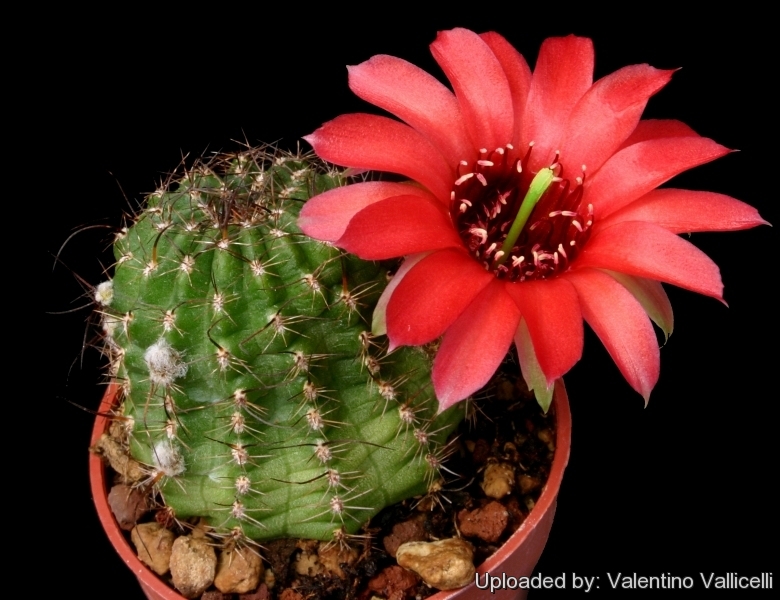
Echinocactus saltensis (Echinopsis saltensis) Photo by: Valentino Vallicelli
Origin and Habitat: Echinopsis saltensisSN|16319]]SN|16319]] has wide range and is locally common in Argentina (Salta and Tucumán provinces).
Altitude: 1200 and 2400 metres above sea level.
Habitat and Ecology: This cactus grows in shrublands on clayey soils.
Synonyms:
See all synonyms of Echinopsis saltensis
Description: Echinopsis saltensisSN|16319]]SN|16319]] (best known as: Lobivia saltensisSN|16320]]SN|16320]]) is a very interesting but variable species with several forms and variety. Two subspecies are recognized, the nominate form and Echinopsis saltensisSN|16319]]SN|16319]]subsp. schreiteri (A. Cast) M. Lowry.
Habit: It is a small cactus, usually solitary, or heavily clustering.
Stem: Flattish, egg-shaped or slightly elongated, up to 12 cm tall, 9 cm in diameter, bright green to dark green or almost black.
Areoles: 5-7 mm apart.
Ribs: 17-18.
Roots: Tap root.
Radial spines: 12-14, thin, reddish.
Central spines: 1-4, whisker-like, twisted, asymmetrical, more or less long, interlaced up and in disorder curved up to 3 cm long. The length of spines greatly depends on sun exposure and plant's age.
Flowers: Pretty, shining, small up to 5 cm long, unscented, somewhat bell-shaped-bulgy, dark orange-red or crimson that appears almost black when starting to open. The stamen's filaments are dark red, and bear cream-white contrasting anthers. The stigma lobes are greenish.
Blooming season: The greater part of flowers appears in spring in the first flowering, but the plant can erratically produce some flowers in summer too.
Fruits: Globular, 5 mm in diameter, with little brown wool, up-drying.
Seeds: Globular, small grained.
Subspecies, varieties, forms and cultivars of plants belonging to the Echinopsis saltensis group
- Echinopsis cachensis Speg.
 Echinopsis saltensis Speg.: (subsp. saltensis) Plants with relatively short petals and dark-coloured Stamens. Origin between Tucuman and Salta ( from Alemania to close to Cafayate).
Echinopsis saltensis Speg.: (subsp. saltensis) Plants with relatively short petals and dark-coloured Stamens. Origin between Tucuman and Salta ( from Alemania to close to Cafayate). Echinopsis saltensis var. nealeana (Backeb.) J.G.Lamb.: This plant has usually somewhat larger solitary body than the near var. pseudocachensis, sometimes also with long, curved Central-spines, the red blooms are more spread and rarely yellow too. The fruit and seed are similar to those of the other Varieties.
Echinopsis saltensis var. nealeana (Backeb.) J.G.Lamb.: This plant has usually somewhat larger solitary body than the near var. pseudocachensis, sometimes also with long, curved Central-spines, the red blooms are more spread and rarely yellow too. The fruit and seed are similar to those of the other Varieties.- Echinopsis saltensis var. pseudocachensis (Backeb.) J.G.Lamb.: Only a few cm small, clumping green bodies, with a long carrot root. Ribs about 14 straight. The plants in this population are quite variable and comprises both individuals with long central spines and individuals with short radial spines without central (Respectively named Echinopsis saltensis var. emmae and Echinopsis saltensis var. emmae f. brevispina) The flower is 4-6 cm long and broad, light red to carmine coloured. The fruit and seed are similar to those of the other Varieties. Origin: Escoype.
 Echinopsis saltensis subs. schreiteri (A.Cast.) M.Lowry: has small deep-rooted, clustering stems. Flowers, short-tubed, red and purple to 3 cm long with sharp tipped petals and reddish purple stamens. Distribution: between Tucuman and Salta in north-western Argentina.
Echinopsis saltensis subs. schreiteri (A.Cast.) M.Lowry: has small deep-rooted, clustering stems. Flowers, short-tubed, red and purple to 3 cm long with sharp tipped petals and reddish purple stamens. Distribution: between Tucuman and Salta in north-western Argentina.- Lobivia emmae var. brevispina Backeb.
- Lobivia saltensis var. emmae (Backeb.) G.D.Rowley
 Lobivia saltensis var. multicostata Rausch: The plant of this population are similar to Lobivia saltensis, however with 20 and more ribs, closer spaced areoles and therefore also closer, broom-like Spination. Flower and fruit are alike. Origin: Cuesta de Lajar.
Lobivia saltensis var. multicostata Rausch: The plant of this population are similar to Lobivia saltensis, however with 20 and more ribs, closer spaced areoles and therefore also closer, broom-like Spination. Flower and fruit are alike. Origin: Cuesta de Lajar. Lobivia saltensis var. zapallarensis Rausch: This is the smallest form from the Sierra Zapallar it has only 9-11 sharp-edged ribs, the epidermis is black-green, often also violet coloured with red to orange flowers, the fruit is more oval, however otherwise nearly like Lobivia saltensis.
Lobivia saltensis var. zapallarensis Rausch: This is the smallest form from the Sierra Zapallar it has only 9-11 sharp-edged ribs, the epidermis is black-green, often also violet coloured with red to orange flowers, the fruit is more oval, however otherwise nearly like Lobivia saltensis.
Bibliography: Major references and further lectures
5) Edward Anderson “The Cactus family” Timber Press, Incorporated, 2001
6) James Cullen, Sabina G. Knees, H. Suzanne Cubey "The European Garden Flora Flowering Plants: A Manual for the Identification of Plants Cultivated in Europe, Both Out-of-Doors and Under Glass" Cambridge University Press, 11/Aug/2011
2) David R Hunt; Nigel P Taylor; Graham Charles; International Cactaceae Systematics Group. "The New Cactus Lexicon" dh books, 2006
4) Friedrich Ritter "Kakteen in Südamerika: Ergebnisse meiner 20jährigen" Volume 2, Argentinien/Bolivien, Volume 2 Selbstverlag, 1980
5) Curt Backeberg “Die Cactaceae: Handbuch der Kakteenkunde,” Volume 2 G. Fischer, 1959
7) Walter Rausch “Lobivia: The Day Flowering Echinopsidinae from a Geographical Distribution Point of View” Volumes 1-3 R. Herzig, 1975
8) Urs Eggli, Leonard E. Newton “Etymological Dictionary of Succulent Plant Names.” Springer, Berlin/Heidelberg 2010.
9) N. L. Britton and J. N. Rose “The 'Cactaceae', Descriptions and Illustrations of Plants of the 'Cactus' Family” volume 2 Carnegie Institution, 1920
10) Ortega-Baes, P. & Méndez, E. 2013. Echinopsis saltensis. In: IUCN 2013. “IUCN Red List of Threatened Species.” Version 2013.1. <www.iucnredlist.org>. Downloaded on 31 October 2013.
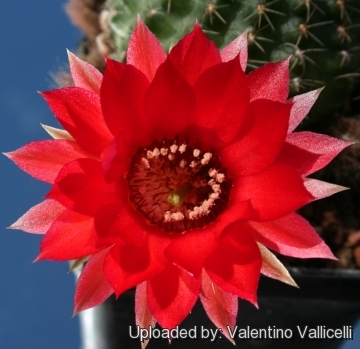 Echinocactus saltensis (Echinopsis saltensis) Photo by: Valentino Vallicelli
Echinocactus saltensis (Echinopsis saltensis) Photo by: Valentino Vallicelli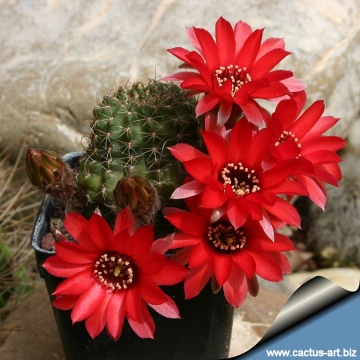 Echinocactus saltensis (Echinopsis saltensis) Photo by: Cactus Art
Echinocactus saltensis (Echinopsis saltensis) Photo by: Cactus Art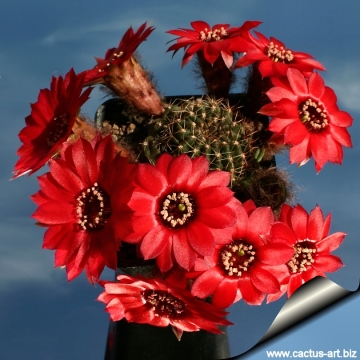 Echinocactus saltensis (Echinopsis saltensis) Photo by: Cactus Art
Echinocactus saltensis (Echinopsis saltensis) Photo by: Cactus Art Echinocactus saltensis (Echinopsis saltensis) Photo by: Cactus Art
Echinocactus saltensis (Echinopsis saltensis) Photo by: Cactus Art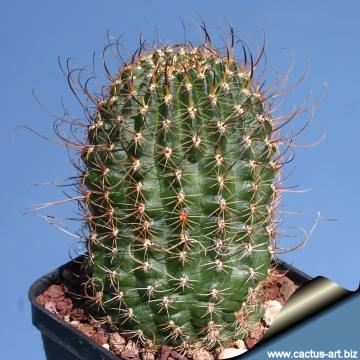 Echinocactus saltensis (Echinopsis saltensis) Photo by: Cactus Art
Echinocactus saltensis (Echinopsis saltensis) Photo by: Cactus Art Echinocactus saltensis (Echinopsis saltensis) Photo by: Cactus Art
Echinocactus saltensis (Echinopsis saltensis) Photo by: Cactus Art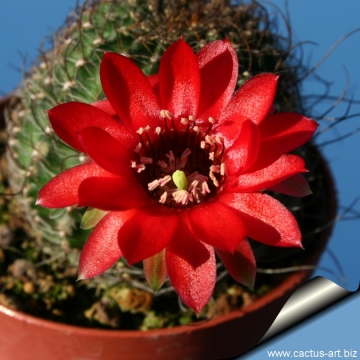 Echinocactus saltensis (Echinopsis saltensis) Photo by: Cactus Art
Echinocactus saltensis (Echinopsis saltensis) Photo by: Cactus Art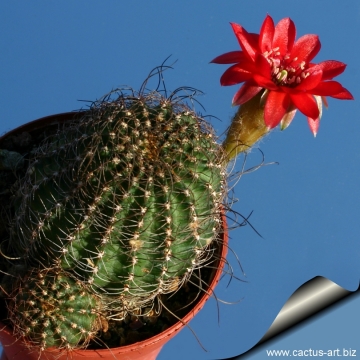 Echinocactus saltensis (Echinopsis saltensis) Photo by: Cactus Art
Echinocactus saltensis (Echinopsis saltensis) Photo by: Cactus ArtCultivation and Propagation: This is a a much decorative frost hardy cactus easily found in cultivation. It is a summer grower species that offers no cultivation difficulties.
Soil: Use a very a particularly draining substratum, as it is very sensitive to rottenness when in presence of humidity and low temperatures and let the soil dry out between waterings, since it's natural habitat is in volcanic soil, it has adapted to more acidic conditions.
Repotting: Repot in the spring, when their roots become cramped. Generally, they should be repotted every other year in order to provide fresh soil. After repotting, do not water for a week or more. Needs a large pot to accommodate a large root system.
Water: In summer, during the vegetative period, it must be regularly watered, but allowing the substratum to completely dry up before irrigating again (but do not overwater ); in winter, it’s to be kept dry. Preferable not to water on overcast days, humid days or cold winter days.
Hardiness: It is a quite frost resistant cactus, hardy to -5° C (- 10° C if very dry). However in cultivation it is better not to expose it to temperatures lower than -0° C, even if in an aerated and protected location, in order to avoid the formation of anti-aesthetic spots on the epidermis. In presence of high atmospheric humidity avoid any frost as it is particularly sensitive to root rot.
Exposure: Outside full sun or afternoon shade, inside needs bright light, and some direct sun, but, as a former mountain dweller, does not care for extremely high temperatures in summer.
Use: It is suitable for small “desert” gardens, in association with other xerophytes. Where the open air cultivation is not possible due to the climate, it is to be cultivated in pot in order to shelter it in winter.
Propagation: By seeds and by cuttings, provided left drying up well, in summer.


















